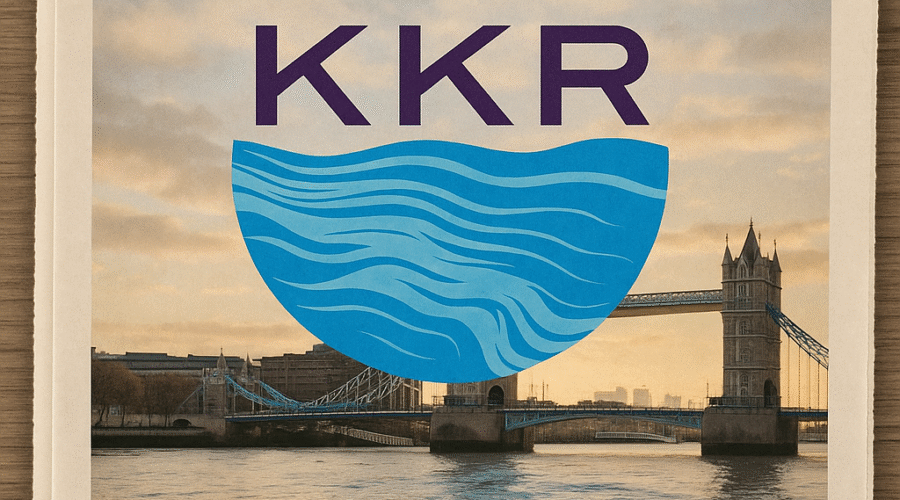The collapse of KKR’s £4 billion rescue bid for Thames Water marks a pivotal juncture in Britain’s infrastructure landscape. As bond prices plunge to record lows and regulators impose unprecedented fines, this crisis exposes systemic flaws in privatized utility models while testing Labour’s ability to reconcile environmental mandates with financial realities. With creditor-led restructuring and temporary nationalization now the only viable paths forward, institutional investors face a paradigm shift in risk assessment for regulated assets.
💼 Seasoned CorpDev / M&A / PE expertise
Deal Collapse Mechanics
KKR’s abrupt withdrawal after two months of due diligence leaves Thames Water’s £22.8 billion debt restructuring in disarray[1][4][7]. The private equity firm reportedly balked at three structural risks: £900 million in pending regulatory fines[2][12], political interference threats from Labour’s water reform agenda[17][19], and unresolved governance conflicts with senior creditors holding £16.3 billion in securitized debt[9][10]. This vacuum forces Thames to pivot to a creditor proposal involving debt-for-equity swaps and £3 billion in emergency liquidity – a plan requiring Ofwat’s approval to avoid special administration by June 30[4][15].
Financial Contagion Risks
The market reaction has been brutal, with Thames’ 2040 bonds crashing 4 pence to 69p and euro-denominated 2027 notes sliding to 68 cents[2][7]. This repricing reflects concerns over:
| Metric | Value | Source |
|---|---|---|
| Net Debt/EBITDA | 9.2x | [4] |
| Pending Fines (2025-2030) | £900M | [2][12] |
| Liquidity Runway | Mid-2026 | [7][15] |
Creditors now demand 200bps higher yields on refinanced debt, potentially adding £460 million annually to interest costs[10][18]. The court-sanctioned restructuring plan’s “June Release Condition” compounds uncertainty by requiring 66.6% creditor approval for new funding[9][18].
Regulatory Reckoning
Ofwat’s £123 million dual fine – £104.5 million for sewage spills and £18.2 million for improper dividends[12] – exemplifies the regulator’s hardened stance. This comes as Environment Secretary Steve Reed accelerates Jon Cunliffe’s water reform commission, whose interim report mandates:
“Fundamental changes to ownership structures, regulatory frameworks, and infrastructure investment models to balance public and investor interests”[13].
The Commission’s preliminary findings criticize Thames’ “extractive dividend policies” under previous owners like Macquarie, which extracted £4.9 billion while debt quintupled[5][11]. New proposals would cap leverage at 60% of regulated asset value and mandate 25-year investment horizons[13][19].
Historical Precedents
Thames’ crisis traces to Thatcher’s 1989 privatization, which transferred £7.6 billion in public assets to private hands without debt[11][15]. The Macquarie era (2006-2017) saw:
- Debt growth: £3.4B → £10.8B[5]
- Dividend extraction: £2.7B[5]
- Infrastructure investment gap: £2.1B vs. regulatory targets[3][12]
This legacy haunts current restructuring efforts, with 40% of Thames’ pipelines exceeding 80 years old and leakage rates at 635 million liters/day[3][12].
Pathways Forward
With KKR’s exit, two scenarios dominate:
- Creditor-Led Recapitalization: Senior bondholders propose converting £7B debt to equity while injecting £1.5B new capital[7][15]. This requires Ofwat to approve 35% bill hikes and fine relief[2][12].
- Temporary Nationalization: The WSAR mechanism would transfer operations to government-appointed administrators, likely writing off 40% of debt[11][20].
Goldman Sachs analysts estimate 55% probability of nationalization, which could cost taxpayers £6B upfront plus £2B/year operating costs[4][11]. However, Labour’s £90B renationalization cost projection makes this a last resort[11][19].
Sector-Wide Implications
The crisis accelerates three structural shifts:
- Regulatory Arbitrage Closure: Ofwat’s new “equity lock” rules prevent dividend payments until infrastructure targets are met[13][19]
- ESG Repricing: Water utilities now face 150-200bps higher borrowing costs vs. energy networks[4][10]
- Ownership Model Innovation: Welsh Water’s not-for-profit structure gains traction as alternative[13][19]
As Bain & Company notes: “The Thames debacle will force PE firms to reevaluate infrastructure investment theses, particularly around regulatory risk pricing and environmental liability timelines”[4].
Conclusion
KKR’s retreat from Thames Water epitomizes the collapse of the post-privatization consensus. For investors, it underscores the need for:
- Enhanced regulatory risk modeling in due diligence
- Active engagement with public stakeholders on ESG issues
- Portfolio diversification into less politicized infrastructure classes
As the Cunliffe Commission finalizes its recommendations, the water sector’s future hinges on balancing investor returns with public accountability – a tightrope walk that will define UK infrastructure investment for decades.
Sources
https://abcnews.go.com/Business/wireStory/us-private-equity-firm-kkr-drops-bid-buy-122439028, https://economictimes.com/news/international/business/thames-water-on-the-brink-after-kkr-drops-out-of-rescue-deal/articleshow/121594555.cms, https://www.thameswater.co.uk/news/thames-water-secures-government-approval-on-plans-to-protect-future-water-resources, https://www.ainvest.com/news/thames-water-debt-crisis-crossroads-uk-infrastructure-investment-2506/, https://www.desmog.com/2025/05/01/thames-water-prospective-new-owner-kkr-donated-1-million-donald-trump-inauguration/, https://www.youtube.com/watch?v=mVuPCw8deuI, https://www.morningstar.com/news/dow-jones/202506032681/kkr-pulls-out-of-thames-water-rescue-deal-update, https://news.sky.com/story/thames-water-survival-hopes-suffer-fresh-blow-13378440, https://www.paulweiss.com/insights/client-memos/three-s-a-crowd-the-thames-water-restructuring-plan-s, https://www.lw.com/admin/upload/SiteAttachments/Holding-Water-Thames-Water-Restructuring-Plan-Sanctioned.pdf, https://www.independent.co.uk/news/uk/home-news/thames-water-bankruptcy-administration-nationalise-bills-labour-b2685605.html, https://abcnews.go.com/Business/wireStory/britains-biggest-water-firm-hit-record-fine-sewage-122257412, https://questions-statements.parliament.uk/written-statements/detail/2025-06-03/hlws676, https://www.bnnbloomberg.ca/business/international/2025/06/03/us-private-equity-firm-kkr-drops-bid-to-buy-troubled-british-utility-thames-water/, https://www.gbnews.com/news/thames-water-kkr-drops-out-investment, https://www.the-independent.com/news/business/group-of-thames-water-creditors-lose-alternative-restructuring-plan-bid-b2700843.html, https://www.streetinsider.com/General+News/KKR+&+Co.+(KKR)+cites+political+risk+in+withdrawal+from+Thames+Water+rescue+deal+-+FT/24889774.html, https://www.cliffordchance.com/content/dam/cliffordchance/briefings/2025/02/english-court-approves-thames-waters-interim-restructuring-plan.pdf, https://www.watermagazine.co.uk/2025/06/03/kkr-pulls-out-of-thames-water-deal/, https://www.telegraph.co.uk/business/2025/06/03/thames-water-future-doubt-private-equity-backer-pull-out/





